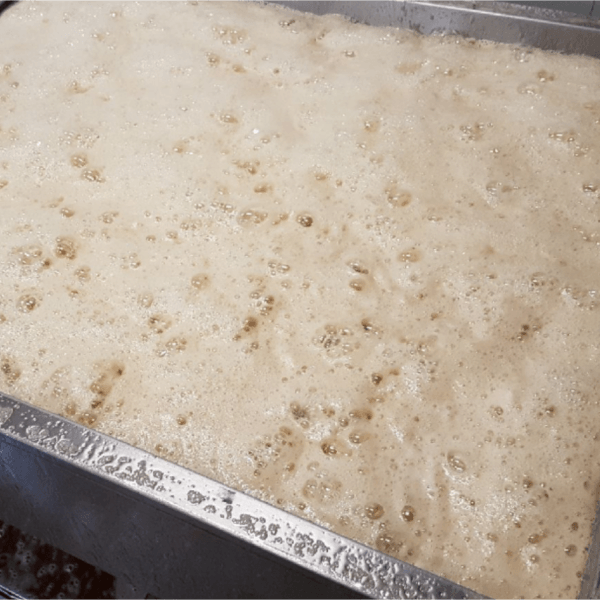Contents
Introduction
Have you ever wondered, “why is my oil foaming?” You’re not alone! Foaming oil can be both annoying and confusing, but understanding it is crucial for achieving the best results in your cooking. In this article, we’ll dive deep into the causes of oil foaming, how to manage it effectively, and the best practices to keep your frying experience smooth. So grab your apron and let’s get frying!
Understanding Foaming in Oil

Let’s start with what causes foaming in cooking oil. It usually happens due to the release of gases, moisture, or impurities in the oil. Yes, you heard that right! If you’re frying at high temperatures, especially with oil that isn’t fresh or clean, you might notice a bubbling mess. Those gas bubbles form when water interacts with the hot oil, leading to a showdown that can create a chaotic cooking environment.
Causes of Foaming
1. Gas Release During Frying: This is a primary culprit. As food cooks, gases are released. If your oil isn’t filtering out those bubbles effectively, they can pile up.
2. Moisture and Impurities in Oil: Even a bit of water can create a cyclone of bubbles. If you’re using old oil, it probably has leftover food particles and moisture that contribute to the problem. When my oil starts foaming more than usual, it’s a red flag to check its condition!
Strategies for Managing Foam

Now that we understand why oil can foam, let’s talk about strategies to keep it under control. Here are a few practical steps I’ve personally found helpful.
Regular Oil Maintenance
Maintaining the cleanliness of your frying oil is critical. This means filtering and changing your oil regularly. Trust me, after trying different methods myself, I’ve learned that:
– Cleaning and Filtering: When you filter out food particles, you not only reduce irritants but also keep the oil fresher. Consider using this handy oil filter my buddy recommended!
– Monitoring Oil Quality: Keep an eye on your oil’s color and smell. If it’s dark or has a funky odor, it’s time to change it. Fresh oil can significantly reduce foaming.
Temperature Control
Next up, let’s tackle temperature control. It’s one of the easiest and most effective ways to prevent excess bubbling.
– Maintaining Optimal Frying Temperatures: If you’re frying food, aim for that sweet spot—usually between 350°F to 375°F. If you go too high, your oil can break down and start foaming up like a party at my place!
– Effects of Overheating: Overheating oil can cause it to degrade faster and foam more. If you notice excessive foaming, check your thermometer!
Selection of Frying Oil
Not all oils are created equal. Choosing the right oil can really make a difference.
– Characteristics of High Smoke Point Oils: Oils like canola or peanut oil have high smoke points and are less likely to foam when heated properly. Finding a good oil can change your frying game.
– Recommended Oil Types: I swear by canola oil—it’s versatile and has a neutral flavor. When I’m in the mood for something rich, peanut oil is my go-to.
Community Insights on Foaming
It’s always great to learn from others. I’ve scoured forums and chats and found some interesting insights on why oil can foam during cooking.
User Experiences
Many home cooks, just like you and me, have shared their experiences. Whether they were confused or annoyed by foaming oil, it seems everyone has a tip or two they swear by.
Some of the community’s best advice includes handling delicate foods differently and keeping an eye out for moisture. If you’re not letting your food dry off first, you’re just asking for trouble!
Controlling Foaming Techniques
Let’s explore some additional techniques to keep that foam at bay.
Use of Anti-Foam Agents
– Overview of Commercial Options: There are a few commercial anti-foam agents available that promise to beat that bubbling menace. However, make sure to read labels; you want something food-safe.
– Safety Considerations: Not all products are created equal, so always double-check that what you’re using is safe for your cooking!
Reducing Moisture
You know that moisture is a big problem when frying. So how do we tackle it?
– Importance of Drying Food Before Frying: This is a great way to significantly cut down on foaming. I’ve found that patting chicken dry makes a world of difference.
Capacity Limits
The size of your fry batch matters!
– Effects of Overcrowding the Frying Pan: If you toss in too much at once, you may generate extra moisture and steam, leading to instantaneous foaming.
– Recommendations for Portioning Food: I’ve learned from experience to fry in smaller batches. It’s easy to get carried away, but trust me, it’s worth it.
General Tips for Frying Oil Management
Now that we’ve covered the science and solutions, here are some general tips that can enhance your frying adventures.
– Regular Oil Quality Checks: Make it a habit to check your oil before you start. It’s just good practice!
– When to Change Frying Oil: If your oil is darker than usual, it’s time to say goodbye.
– Best Practices for Optimal Frying Results: Keep your frying area clean and the oil filtered for the best results. Your food will thank you!
Conclusion
Managing foaming oil is essential for a smooth cooking experience. If you’ve found this information helpful, I’d love to hear your thoughts! Feel free to leave a comment, share your experiences, or check out more delicious content on Smokerestaurant.com.




